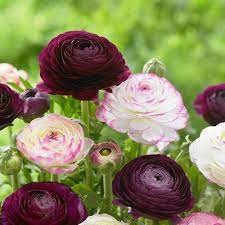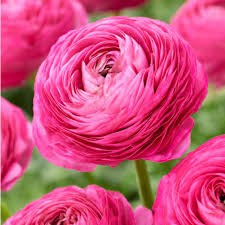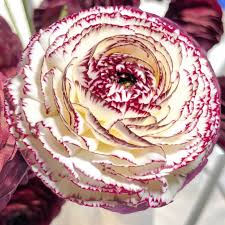Ranunculus plants look almost too ideal to be accurate. Their rose-like blossoms have tissue-thin petals, and they come in colorings that range from cream and faded yellow to apricot, red, orange, red, and burgundy. Though now not frequently seen in domestic gardens, the first-rate vegetation of ranunculus is a staple in excessive-give-up flower stores and wedding ceremony bouquets. If you are a fan of ranunculus flower, why no longer attempt to develop them yourself. The corms can be planted in boxes or inside the garden so that you can experience those beautiful blooms both indoors as reduced plants and outdoors in flower beds, borders, and box plantings. Shop our selection of ranunculus.
Table of Contents
Start with a Quality Plant
Ranunculus develop from corms that resemble little claws. Large corms comprise greater stored food electricity than small corms. They could give you a more vigorous plant with extra plants—Longfield Gardens components 6/7 cm ranunculus bulbs corms so you can revel in the largest, brightest blooms.
ranunculus flowers do nicely in locations with mild winters and lengthy, cool springs, even though they may do well in zones three via 10. In zones 8 through 10, plant in the fall. Regions with colder winters (zones three via 7) can plant in early spring as soon as hard frosts have passed.



Types of Ranunculus
There are several species of ranunculus corms, starting from local wildflowers to cultivars bred for showy blossoms.
·R. Carolinianus:
Carolina buttercup is a local iciness annual or brief-lived perennial in low woods and damp thickets.
·R. Flammula:
Often known as lesser spearwort or sagebrush buttercup, this native ranunculus has 5-petaled, small, solitary yellow flora along lakeshores and other shallow water.
·R. Repens:
Creeping buttercup is a weedy perennial that spreads to 36 inches extensive. Native to Europe and Asia, it has naturalized in temperate regions at some point of maximum of the U.S. And Canada.
·R. Asiaticus:
A tuberous-rooted plant that blooms in late spring to early summer, the cup-formed, poppy-like vegetation of the oft-called Persian buttercup has extraordinary purple-black anthers. sola wood flowers.
·R. Asiaticus hybrids:
These are the butterfly ranunculus plants offered by florists. The tuberous corms available for home gardening are hybrids with specific features of stem length, color, and petal quantity in step with bloom.
How to Grow Ranunculus From Seed
Most ranunculus plant life is grown from corms, but providing them from seeds is impossible. The seeds must be planted indoors approximately 12 weeks before the average date of your last spring frost.
1. Fill a seed-beginning tray with a growing blend and water until the mixture is moist; however, it should not be standing in water.
2. Sprinkle planting ranunculus bulbs seeds generously on the pinnacle of the developing mix, then add a skinny layer of seed-starting mix over the seeds. After you are finished, press the soil down lightly with your hand.
Three. Place the seeds below a develop mild and maintain the tray at a temperature of 50 degrees Fahrenheit till they germinate in approximately 20 to 30 days.
4. Thin the flowers when the seedlings are approximately 2 inches high and keep developing below the grow lighting fixtures.
5. Transplant the seedlings into 2—to 3-inch pots and begin to harden off the seedlings while daylight temperatures are inside the upper 40s. Bring the interior of the flower at night or every time frost threatens. sola flowers.
6. Plant in the garden while temperatures are reliably inside the top 50 to 60-diploma Fahrenheit range. growing ranunculus. sola flowers.
Ranunculus Care
The care of ranunculus can vary depending on your USDA hardiness zone. If you plant them in Zone 8 or warmer, they can grow as perennials, but decide on mild and dry summers. white ranunculus are commonly planted in fall or wintry weather in warmer areas so that you can bloom in early spring before the summertime warmness arrives. Unless you’ve got an excessive tunnel or greenhouse in cooler zones, you must begin the corms in a planting tray in early spring, approximately 4 weeks before the ultimate frost date. Regardless of when or where you plant them, ranunculus must be included when frost is expected.
Ranunculus thrives in total solar and organically enriched, well-drained soil. Gardeners can use raised beds if the native soil is not conducive to growing. At the cease of the season, permit the plant life to return. The bulbs in the floor decide on dry soil when dormant, so if you can’t offer that, it’s exceptional to deal with them as an annual. Regardless of where you stay, the one thing you’ll want to display is the degree of moisture in the soil. If the floor is too wet, there’s a high chance that the plant will rot.
Light
Ranunculus require complete solar radiation, or at least six hours of direct solar a day, to develop and bloom well. In hotter climates, a bit of protection from afternoon sun can be beneficial.
Soil
Plant ranunculus in loamy or sandy soil. This is slightly acidic and has good drainage. Enrich the soil by blending it in compost. Ranunculus do no longer tolerate clay. If the floor conditions appear negative, you could usually plant ranunculus bouquet in raised beds for an extra-managed environment.
Water
When first planting corms, soak them in water for as much as 4 hours before planting. This will stimulate an increase. The soil must be saved lightly moist while ranunculus is first sprouting and growing (see commands for planting below “Potting and Repotting Ranunculus.”) After you start to see the brand new flora sprouting up, you can begin an everyday watering habitually. ranunculus ficaria lesser celandine doesn’t respect soggy soil, so don’t overdo it. Once the vegetation is extra established, waiting until the soil is a little dry before watering is desirable.
Temperature and Humidity
Ranunculus likes cool spring weather but can not live in a problematic frost. Protect your flowers with frost fabric on bloodless nights or maintain them in a relaxed environment around 50ºF (along with in a greenhouse, excessive tunnel, or sunny storage) until it’s time to plant them out of doors.
Add mulch across the base of the vegetation to shield them from the summer season warmness. If you don’t, anticipate ranunculus ranunculus to be dormant once temperatures exceed 90ºF or even quicker. If situations are hot and moist, the corms will rot, and the flowers will die.
When flowering tapers off and leaves begin to yellow, forestall water the vegetation and permit the foliage to die lower back. Where tuberous roots are hardy within the ground, they may be left undisturbed as long as the soil is dry during summer.
Fertilizer
You may begin a fertilizing routine after the primary few ranunculus seeds leaves appear. Deliver a slow-release fertilizer for vegetation as soon as a month, following the product label’s instructions for exceptional consequences.
Common Pests & Plant Diseases
Birds are keen on flower ranunculus shoots, so shield sprouting plants with netting or twine. You can also start flora in pots or residences, then set them inside the garden when they are 4-6 inches tall (a length that is much less appealing to pesky birds). Deer no longer hassle them. Aphids may be managed with insecticidal soap or horticultural oil.
Excess humidity and watering can infect the leaves with microorganisms, fungi, or powdery mould. Avoid watering during the night and decrease watering if desired. Improve air movement if feasible. A serious powdery mold problem can be treated with the appropriate fungicide.
Frequently Asked Questions
What month does ranunculus bloom?
In warmer climates, ranunculus may be planted in the fall and begin blooming in late iciness or early spring. In frostier climates, peach ranunculus are planted in spring and bloom in late spring or summer.
Do ranunculus bulbs unfold?
Some ranunculus species are weedy or invasive. Still, Persian buttercups are commonly grown annually because they require moderate winters and dry and moderate summers. The bulbs can spread if they perennialize to your lawn.
How poisonous are ranunculus?
Persian buttercups can cause pores and skin infections, from redness to blisters. The plant is poisonous when eaten in large portions, causing burning within the mouth and gastrointestinal troubles.
Does ranunculus constantly come again each year?
Ranunculus can come lower back every year if given the proper care. Though perennials, many gardeners treat ranunculus flower bouquet as an annual and begin with new corms every spring because the flora does not do nicely in freezing temperatures.
Does ranunculus bloom greater than as soon as in step with yr?
when to plant ranunculus only blooms as soon as it is consistent with the year, but if the bulbs are left in the ground, they can bloom once more in the following 12 months.
Does ranunculus flora multiply?
Ranunculus can multiply independently, but you can propagate it using division.